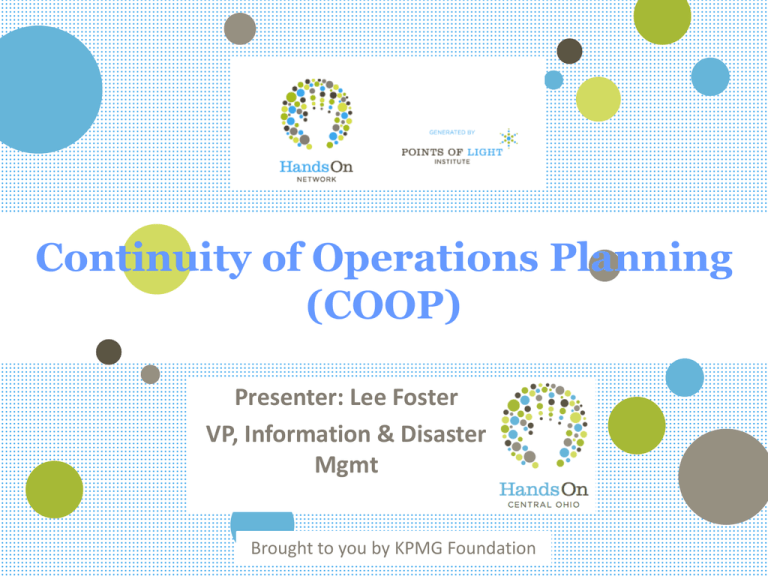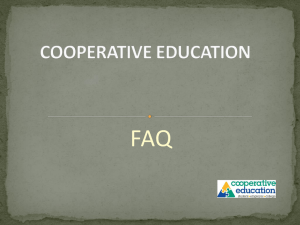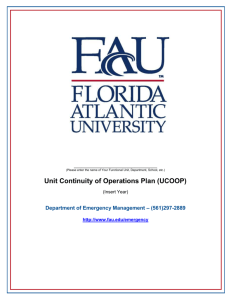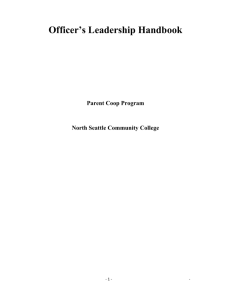COOP - HandsOn Network
advertisement

Continuity of Operations Planning (COOP) Presenter: Lee Foster VP, Information & Disaster Mgmt Brought to you by KPMG Foundation Continuity of Operations Planning Lee W. Foster, MS Vice President, Information & Disaster Management HandsOn Central Ohio Outline This training is typically divided into 10 Modules Module 1: Principles of COOP Module 2: Essential Functions Module 3: Human Capital Management Module 4: Delegations of Authority Module 5: Vital Records Module 6: Alternate Sites Module 7: Communications Module 8: Reconstitution & Devolution Module 9: Writing a COOP Plan Module 10: Training & Exercising Principles of COOP The key to COOP planning is to be sure it addresses “All Hazards” What are some of the Hazards we face? Floods Severe Winter Storms (snow/ice) Dam failure Terrorism Infectious Diseases Tornadoes Source: 2010 Franklin County Emergency Management & Homeland Security Risk Assessment Principles of COOP 8 Principles of COOP Essential Functions Human Capital & Key Personnel Delegations of Authority & Succession Vital Records Alternate Facilities Communications Reconstitution & Devolution Tests, Training & Exercises Principles of COOP Without a COOP plan, agencies cannot function and provide essential functions Good public relations Consistency of services COOP planning is just good business practices Principles of COOP 6 Goals of COOP Ensure timely and orderly continuous performance of essential functions during and after an emergency Protect facilities, equipment, records and other assets that support essential functions. Reduce or mitigate disruptions to operations Principles of COOP 6 Goals of COOP (cont.) Facilitate reconstitution and devolution after an emergency Minimize loss of life, injury and property damage Provide family support planning for agency personnel during an emergency. Principles of COOP COOP plans should: Be operational no later than 12 hours after activation Be able to maintain sustained operations for at least 30 days. Principles of COOP 7 phases of COOP development COOP Program initiation Identification of functional requirements Plan design and implementation Program implementation Tests, Training and Exercises (TT&E) Plan revision and updating Plan execution Essential Functions What are essential functions? Must be performed to achieve agency’s mission Provide vital services Maintain safety & well being of citizens Sustain industrial/economical base Should be resumed within 12 hours of disruption Should be sustainable for up to 30 days Essential Functions 4 steps in identifying essential functions Identify ALL functions Identify essential functions as a subset Determine resource requirements Prioritize essential functions Vital Records Definition of Vital Records: Records, systems and equipment that if irretrievable, lost or damaged will materially impair an organizations ability to carry out essential functions. Vital Records Emergency & Legal Records Emergency Records: Essential to the continued functioning of an agency during and after an emergency to ensure continuity of operations. Legal: Essential to the protection of the legal and financial rights of an agency and of the individual directly affected by the agency’s activities. Vital Records Are those records really vital? The National Archives and Records Administration estimates no more than 7% of records are vital (likely 3 – 5%). Vital Records Building a Vital Record “Go-Kit”: A hard copy of key personnel and disaster staff phone numbers. Vital records inventory with precise locations. Necessary keys or access codes. Maps and blue prints of alternate facilities. Access requirements and sources of equipment necessary to access records. Lists of records recovery experts and vendors. Copy of the agency’s COOP Plan. Alternate Sites Selecting an Alternate Site: Location Building Type Space Distance/Transportation Communications Security Lodging/Food Accessibility Cost Alternate Sites Let’s define a Hot Site A “hot” site is an alternate facility that already has in place the computer, telecommunications, and environmental infrastructure necessary to recover the agency’s essential functions. A hot site is basically like have an exact replica of your original building. Alternate Sites Let’s define a Warm Site: A “warm” site is an alternate work site equipped with some hardware and communications interfaces, as well as electrical and environmental conditioning capable of providing backup after additional software or customization is performed and/or additional equipment is temporarily obtained. Alternate Sites Let’s define a Cold site: A “cold” site is an alternate facility that has the environmental infrastructure necessary to recover essential functions or information systems, but does not have preinstalled computer hardware, or telecommunications equipment. The agency must make arrangements for computer and telecommunications support within 12 hours of COOP activation to make a cold site viable. Alternate Sites Tele-work Tele-work is another option for continuing operations if your facility is inaccessible. Tele-work allows employees to work from home during a potential disaster. Became the “go to” method of operations during the 2009 H1N1 outbreak (Social Distancing). Training & Exercising Why Bother? It’s important to train and exercise your plan. It helps to verify that the plan works and that staff are familiar with their expectations during COOP operations. By effectively simulating a COOP situation, staff will understand how to react when the plan “fails”. Training & Exercising A few other points Training and exercising provide excellent opportunities to update your plan. Encourage cross training among departments. “Non-essential” staff could be asked to assist in essential function programs. Training & Exercising Types of Exercises Discussion based exercises: Seminars Workshops Table-Top Operations based exercises: Drills Functional Full Scale Training & Exercising How can you get involved with Exercises? If you have a function that would aid in the response to an emergency or disaster (sheltering, providing food, medical care) contact you local Emergency Management Agency for more information on how you can become involved. If you want to test your own plan, you can conduct a Drill. (A single agency, testing a single function) Training & Exercising Developing a Drill Once you’ve decided to conduct your own exercise, a drill, you will need to make sure your objectives are SMART Simple: Easily understood Measurable: can be gauged against a standard Achievable: challenging, but not impossible Realistic: Plausible for the agency Task Oriented: tied to something you want to improve Training & Exercising Improvement Planning Once you’ve completed your Drill (or real life event) it is important to conduct an After Action Report / Improvement Plan (AAR/IP). In the AAR/IP you will want to list what went well, what needs improving and lessons learned. Training & Exercising Improvement Planning (cont) You’ll want to use the items that need improving and construct your Improvement Plan An improvement plan is a chart that lays out what was identified as needing improvement, how it will be improved, who is responsible for the improvements and when will the improvements be completed. Conclusion COOP planning is intended to be an extensive process. Do not rush through your COOP planning, your plan will fail if you do. Be sure to test your plan whenever possible. Seek outside resources, like HandsOn Central Ohio, for assistance. Questions/Follow Up Lee Foster, MS Vice President, Information & Disaster Management lfoster@handsoncentralohio.org 614-221-6766 x 168











